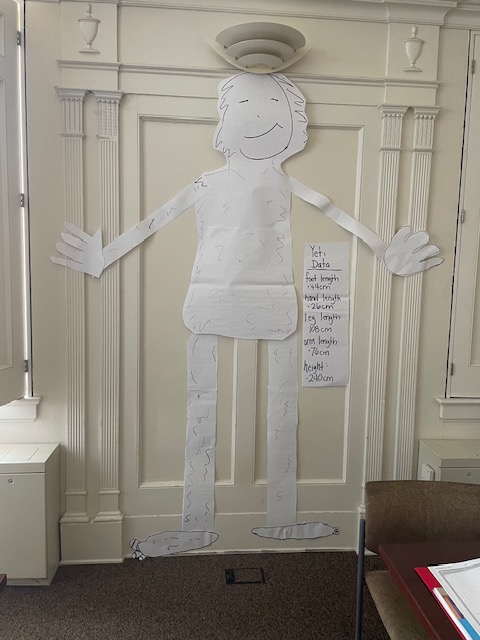Fall Saturday SAVY, Week 2, Encounters with Measurement (1st-2nd)
Our second Saturday of Encounters with Measurement was a busy one! Following a quick community-building game of “Four Corners”, our young mathematicians got right to work on problem-solving tasks involving measurement. They started the day calculating the differences between estimates and actual measurements made last week. Students engaged in sense-making discussions about reasoning for their original estimations.
Next, while searching for the Yeti through the Himalayas, our young members of the Yeti Institute of Discovery came across what appeared to be a Yeti footprint! They learned that the Yeti’s footprint was twice the size of a fellow explorer. The team made a generalization that if the foot of the Yeti was twice as long as the explorer, then other body parts would also be twice as long. To determine the size of the Yeti, the team doubled the measurements of their fellow explorer and worked together to build a model of the Yeti. With everyone working cooperatively, the model of the Yeti turned out great!
After creating the Yeti, our explorers found a rectangular pen in the Himalayas. The pen was too small for a Yeti to lie down in, so the team decided that the pen must have been where the Yeti kept his pet. They discovered that the pen had a perimeter of 56 feet. After learning about perimeter, explorers calculated all the possible dimensions (such as 1ft X 27ft, 2ft X 26ft, 3ft X 25ft, etc.) for the rectangular pen if they were given 56 feet of fencing. They worked in table groups to draw models on grid paper of the different pens and calculate the area by counting squares. Through exploration, students discovered that area can be calculated by multiplying the length by the width of a rectangle. They also looked at patterns and discovered that the closer the length and width are, the greater the area. Therefore, when comparing rectangles with the same perimeter, the greatest area of a rectangle occurs when the length and width are the same (creating a square).
At the end of the day, learners explored the area of irregular shapes. They traced their hands and feet on grid paper and counted all the whole and partial squares. They divided the partial squares by two and then added the sum to the number of whole squares to find the area.
At Home Challenge:
This week at home, encourage your child to find the perimeter and area of different objects around your house. For our weekly “Think Beyond” question, students may bring in their answers next week for discussion.
Think Beyond Question: Assuming you had 40 feet of fencing to make a pen, find all the different rectangular pens you could make. Which one would have the most space inside (greatest area)? How do you know?
Wishing you a wonderful week! Next week, students will be learning about measuring liquid volume. We look forward to seeing everyone again soon!
Ms. Davidson (Instructor) & Ms. Masoomi (Classroom Assistant)


